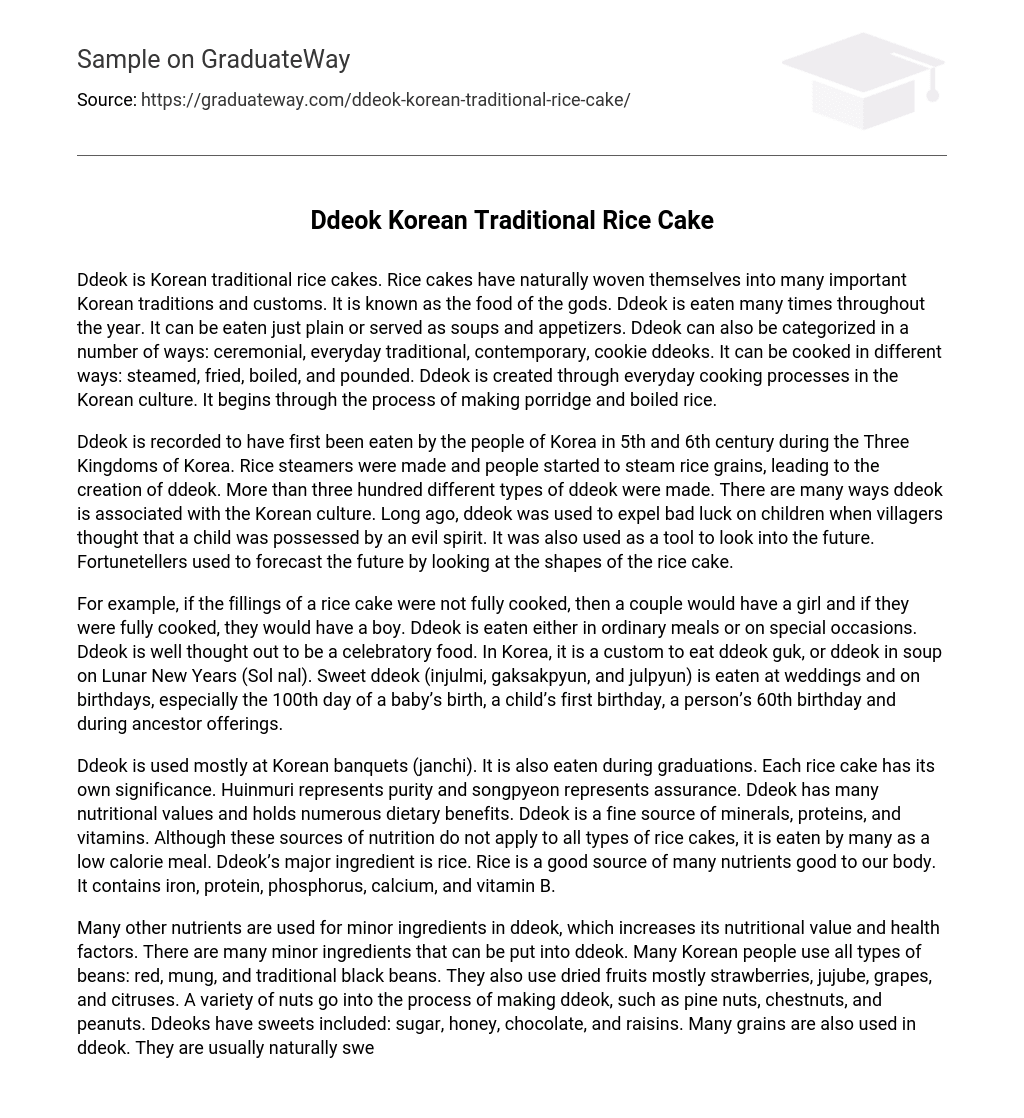Ddeok, also known as Korean traditional rice cakes, plays a significant role in many important Korean traditions and customs as the revered food of the gods. It can be enjoyed all year round, whether it is plain or incorporated into soups and appetizers. Ddeok comes in various forms, such as ceremonial ddeoks, everyday traditional ddeoks, contemporary ddeoks, and cookie ddeoks. The preparation methods for ddeok differ and can include steaming, frying, boiling, or pounding. The process of making ddeok is closely connected to everyday cooking practices in Korean culture and starts with the creation of porridge and boiled rice.
Ddeok, a type of rice cake, has a long history in Korean culture. It is believed to have originated during the Three Kingdoms of Korea in the 5th and 6th centuries. The creation of ddeok can be traced back to the introduction of rice steamers, which allowed people to steam rice grains and create the cake. Over time, more than 300 different varieties of ddeok were developed.
Aside from its historical significance, ddeok also holds cultural associations in Korea. In the past, it was used as protection against bad luck for children who were believed to be possessed by evil spirits. Additionally, ddeok served as a fortune-telling tool where fortunetellers would analyze the shapes of these rice cakes to make predictions about future events.
For instance, if the rice cake’s fillings were not fully cooked, then a girl would be born to the couple, whereas if they were fully cooked, a boy would be born. Ddeok is consumed both in everyday meals and during special occasions. It is considered a festive food in Korea. On Lunar New Year (Sol nal), it is customary to eat ddeok guk, which is ddeok in soup. Sweet ddeok varieties like injulmi, gaksakpyun, and julpyun are enjoyed at weddings and birthdays, particularly on significant milestones such as a baby’s 100th day, a child’s first birthday, a person’s 60th birthday, and during ancestor offerings.
Ddeok is commonly enjoyed at Korean banquets (janchi) and graduation ceremonies. Each rice cake carries its own symbolism, with Huinmuri representing purity and songpyeon representing assurance. In addition to its symbolism, ddeok also provides various nutritional values and dietary benefits. It is a rich source of minerals, proteins, and vitamins. While the nutritional content may vary among different types of rice cakes, many people choose ddeok as a low-calorie meal option. The primary ingredient in ddeok is rice, which is renowned for its nutritional advantages such as iron, protein, phosphorus, calcium, and vitamin B.
Adding various nutrients to ddeok enhances its overall nutritional value and promotes good health. Ddeok can incorporate a range of minor ingredients, including different types of beans such as red, mung, and traditional black beans. Dried fruits like strawberries, jujubes, grapes, and citruses are commonly used. Nuts such as pine nuts, chestnuts, and peanuts are also included in the ddeok-making process. The ddeoks may contain sweet components like sugar, honey, chocolate, and raisins. Additionally, various grains are used, known for their natural sweetness and numerous nutritional benefits.
Ddeok is made with a variety of ingredients, such as sesame seeds, sesame oil, ginger, Korean mugwort, Korean wine (makgulli), red wine, and alcohol. It also includes different medicinal herbs and flowers that add to its pleasant scent and attractive colors. The choice of flowers used depends on the occasion and the season. For example, azaleas are used in spring while chrysanthemums are preferred for fall celebrations. In addition to its main component of rice, ddeok offers several health benefits. Rice is known for its effectiveness in relieving indigestion, diarrhea, nausea, skin conditions, and hypertension.
The sesame seed and sesame oil contain essential fatty acids that are advantageous for the human body and possess anti-aging properties. The various grains in ddeok provide medicinal advantages such as alleviating constipation, safeguarding against neural tube defects during fetal development, offering a rich source of fiber, and functioning as an antioxidant. The fruits incorporated into ddeok contribute vitamins to the body. Additionally, medicinal herbs with antioxidants are included to address diverse ailments in ddeok. Specifically, Korean mugwort is added to soothe the nervous system and assist in managing epilepsy.
Korean mugworts have numerous benefits including combating the common cold, improving digestive disorders, and detoxifying the body. They are also effective in treating fatigue, headaches, and stomach pain. Moreover, Korean mugworts are crucial for maintaining uterine health.
Ddeok is a famous Korean dish that carries immense cultural, historical, and traditional significance in Korea. It has become an essential part of almost every individual’s life in Korea. Furthermore, it has gained popularity not just in Korea but also in other countries such as China, Japan, and America.





